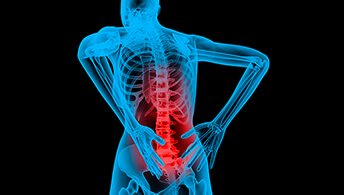What is an Intrathecal Pump?
Intrathecal pumps can help ease and manage chronic pain. An intrathecal pump is approximately the size of a deck of cards, and consists of one or more catheters, along with an implantable pump. The device is implanted through the abdomen, into the area around the spinal cord known as the intrathecal space, where it administers a measured drug dosage that goes directly to the central nervous system, minimizing side effects and maximizing chronic pain relief.
Often Used to Treat:
Intrathecal pumps deliver medication directly along the signals where pain travels, allowing the medication to work much more quickly than medication taken orally. As a result, side effects associated with oral medication are reduced, less medication is needed, and patients receive sustained relief, resulting in a better quality of life.
Intrathecal pumps can help alleviate pain associated with:




Who is a Candidate for an Intrathecal Pump?
An intrathecal pump is an excellent option for patients who have found conservative treatment options to have failed. Additionally, optimal intrathecal pump candidates may be those who experience severe side effects from oral medication or who have had a failed surgery or surgery is not an option.
A psychological evaluation is often administered prior to implanting an intrathecal pump, so those with previous psychiatric conditions may not be optimal candidates.
What is the Procedure for an Intrathecal Pump?
The success of an intrathecal pump depends on a successful trial to measure a patient’s response to therapy. This may be done in the following ways:
- An intraspinal morphine injection to monitor reaction and pain relief
- An epidural injection
- A catheter system providing continuous drug infusion
Pain reductions with these methods can vary but are considered successful if the pain is reduced by 50% or more.
If a patient is deemed a successful candidate, an intrathecal pump is implanted on an outpatient basis. Patients are first put under anaesthesia before a physician uses a fluoroscopy, or live X-ray, to guide the implementation of the intrathecal pump. The pump is then inserted into either side of the abdomen before the catheter is connected and situated into the intrathecal space. Lastly, the pump is filled with medication and tested.
The medication in an intrathecal pump is intended to last up to three months, at which point, additional medicine is injected into the pump by needle.
What Happens after an Intrathecal Pump?
A short hospital stay may be required after an intrathecal pump procedure, but most patients are able to go home within hours after the procedure. Although patients experience some initial soreness, especially around the incision sites, the benefits of the pump can be felt almost immediately. Patients sometimes experience a headache that lasts several days and daily activities should be resumed gradually.
Risk Factors Associated with Intrathecal Pumps
While an intrathecal pump can be an effective way to resolve chronic pain, as well as offer an alternative to taking oral medication, there are risks involved, such as:
- Headache
- Bleeding
- Infection
- Device malfunction
- Paralysis
- Allergic reaction

At 360 Pain Treatment, our mission is to provide compassionate pain relief, restore prior function and activity levels, and optimize the quality of life for all.

360 Pain Treatment aspires to create a culture of care in our communities by helping those suffering with pain to live more pain-free and thus improving their quality of life.

- Compassion for all who are ailing and in need of help.
- Advancement of minimally invasive healthcare procedures that firstly considers patient wellbeing.
- Respect and inclusion for everyone we serve in our communities.
- Excellence and efficiency in all that we do.








